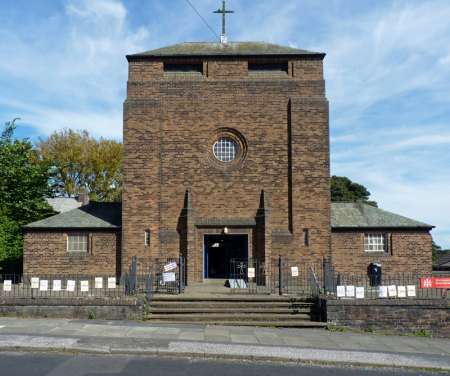St Gabriel's Church, Bishop’ s Road, Sedgley Park, Prestwich
Increasing prosperity from cotton manufacturing, saw the population of the area start to increase from 1906 onward and the Rev Cooper rector of St Mary's, Prestwich in whose parish it then lay, took note: "A new church will soon be needed in Sedgley Park, and a site must be secured at once" ‑ (June 1908), "Such a challenge as this is a searching test of the spiritual life of this Parish. If we really love God and the church, we shall not be content to let such a precious chance slip" (January 1909). He allocated the task to Rev. M. Selwyn Bell, his curate. In 1909 Rev. Bell left to become a missionary in Guatemala City , but in 1910 a site was found for the church, and on 14th July Prestwich Church Council decided to build an iron church with a tiled roof to seat 300 at cost of £500 (which became £800), excluding furnishings. The church was built on the site of what is now the vicarage garden and was dedicated on 31st October and named for St Gabriel to preserve an association with St Mary's the mother church. We are told "the rain poured down relentlessly". It was soon affectionately known as the "Tin Church".
It was not however until 1926 that a separate parish of St Gabriel was formed, taking in the area known as Hilton Park and the tongue of land alongside Sheepfoot Lane down to the railway at Bowker Vale. Its first vicar was Rev Brian Willett.
On 8"' October 1932 the foundation stone of a new church building, the present one, was laid by the Lord Bishop of Manchester, Dr Guy Warman. The day is described as wet and cold, prompting memories of the dedication of the first church, and most of the service had to be held in the old "Tin Church" which unfortunately had started to decay. The former Bishop of Manchester William Temple ‑ later Archbishop of Canterbury ‑ had discouraged the spending of money on it in favour of moving forward to a new one.)
Consecrated on 30th September 1933 by the Bishop of Manchester, the new building had been designed by the firm of Isaac Taytor and W. Cecil Young. The listing document states that they "were the most significant church practice to work in the Manchester area in the inter‑war years, and their churches are powerful compositions that make the best of limited budgets. St Gabriel's is a carefully considered amalgam of 17th century brick and timber motifs within a massing derived from contemporary Dutch and North German sources that make for a fine, distinctive composition. It is one of the firm's finest churches".
Built from brown Blockley brick with Westmoreland slate roof, it has a squat west tower and is built on a "basilica" plan with an eight bay nave with clerestory windows.The single storey north chapel was formerly a children's comer, being remodelled as a Lady Chapel in 1952 with a stained glass windows and dedicated on 14th February 1954in thanksgiving for the coronation of Elizabeth II by Rt. Rev. F Wood (Bishop of Middleton). During World War II the Lady Chapel was used for all week day services as it was easily blacked out. Every Wednesday evening throughout the conflict special intercessions were made in the chapel after 7 p.m. evensong.
In 1984 the west end of the church was remodelled. A wall was built to incorporate the gallery front and "late 20th Century" doors installed below. Thereby was created the present "narthex" and upper meeting room. The purpose of this was to replace the Church Hall which had been badly damaged in a fire and was felt too expensive to repair. The Hall, built in 1924 and dedicated by Bishop Temple, had for a time from 1930 been rented by the Lancashire Education Authority to house an Elementary School for Infants before the present Sedgley Park County Primary School was constructed. It could be said it still helps to serve the community as a medical practice now occupies the site. The purchase of the hall by the practice helped fund the creation of the narthex.
Foundation Stone laid October 1932.
Consecrated 30 September 1933
Reference ICBS 12066 New Church Grant: Approved
Reference Manchester Guardian, 30 September 1933
Reference Guide leaflet September 2003
Reference Builder
